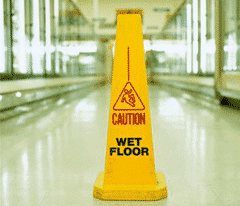
We covered the importance of liability prevention last month, citing research indicating that nearly 1 million slip-and-fall accidents occur each year. These work-related incidents cost businesses countless hours and fiscal resources, ultimately derailing the march towards sustained growth and profitability. In fact, slip-and-fall accidents cost businesses an estimated $12 million between 1998 and 2008.
The first step to alleviating this problem is to recognize its existence. Businesses can no longer turn a blind eye to the prevalence of at-work accidents, thanks in part to reports from insurance companies like Liberty Mutual. Next, businesses need only assess their workplaces in an effort to proactively identify areas of potential hazard:
Floor Mats: Reducing the Potential for Danger
Entryways: Outdoor Areas
Entrance mats may be placed outside of entryways to control dirt and debris before they are tracked into a facility. Such mats are typically made with commercial grade Nitrile rubber capable of enduring harsh weather and temperature changes without cracking, curling, or flaking. Rubber scraper mats are a fine example of these heavy-duty entrance mats, as they feature 100% Nitrile rubber construction and an aggressive surface pattern that effectively cleans dirt. New: ECO Rubber Scraper Mats are becoming more popular as builders, property managers, and Federal legislation begin to push towards eco-friendly commercial products.
Entryways: Indoor, Lobby, and Foyer Areas
Carpet-topped entrance mats may also be placed along the inside of an entryway, lobby, or foyer to control dirt accumulation. More importantly, these mats soak up moisture and prevent puddle formation along tile, hardwood, marble, or other smooth surfaces that become extremely slippery and dangerous when wet.
Vestibules
A vestibule is a passageway that acts as an airlock between the inside of a building and the external environment. Airports, shopping malls, and other highly trafficked areas use vestibules to help moderate building temperature as well as dirt accumulation.
Because vestibules are typically placed in areas that experience persistent traffic, a heavy-duty flooring system may be necessary to control dirt, moisture, and water accumulation. Recessed grill mats are a superb option for vestibule floors, as are recessed floor mats. To learn more about these commercial grade floor mat systems, you may visit our Floor Mat Blog article titled Recessed Mats 101.
Floor Mat Upkeep
Floor mats are only as effective as they are clean. Like a wet sponge, soiled floor mats lose their ability to contain both moisture and other debris. In this way, an unclean floor mat may contribute to slip-and-fall accidents by becoming a wet, slippery, and inconspicuous obstacle for visitors.
In this way, businesses must regularly clean floor mats every 7-14 days depending on individual environments. In general, floor mats need more frequent cleaning when they are exposed to high volumes of foot traffic, wet and rainy environments, or predominantly soil-based environments, like those found at construction sites. A word of caution, however: vacuuming floor mats may remove only 10% of trapped dirt (i). Businesses with commercial floor mats are smart to turn to companies that specialize in floor mat rental and laundering services. Such companies have the industrial machinery needed to deep-clean floor mats to more effectively remove moisture, dirt, and other particles that may be embedded deep below the surface.
(i) http://www.todaysfacilitymanager.com/facilityblog/2010/10/watch-that-step.html






